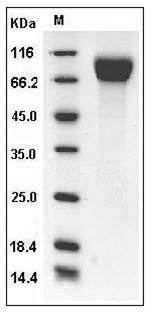-
Product Name
Mouse CSF1R/MCSF Receptor/CD115 (His Tag) recombinant protein
- Documents
-
Description
Tyrosine-protein kinase that acts as cell-surface receptor for CSF1 and IL34 and plays an essential role in the regulation of survival, proliferation and differentiation of hematopoietic precursor cells, especially mononuclear phagocytes, such as macrophages and monocytes. Promotes the release of proinflammatory chemokines in response to IL34 and CSF1, and thereby plays an important role in innate immunity and in inflammatory processes. Plays an important role in the regulation of osteoclast proliferation and differentiation, the regulation of bone resorption, and is required for normal bone and tooth development. Required for normal male and female fertility, and for normal development of milk ducts and acinar structures in the mammary gland during pregnancy. Promotes reorganization of the actin cytoskeleton, regulates formation of membrane ruffles, cell adhesion and cell migration, and promotes cancer cell invasion. Activates several signaling pathways in response to ligand binding. Phosphorylates PIK3R1, PLCG2, GRB2, SLA2 and CBL. Activation of PLCG2 leads to the production of the cellular signaling molecules diacylglycerol and inositol 1,4,5-trisphosphate, that then lead to the activation of protein kinase C family members, especially PRKCD. Phosphorylation of PIK3R1, the regulatory subunit of phosphatidylinositol 3-kinase, leads to activation of the AKT1 signaling pathway. Activated CSF1R also mediates activation of the MAP kinases MAPK1/ERK2 and/or MAPK3/ERK1, and of the SRC family kinases SRC, FYN and YES1. Activated CSF1R transmits signals both via proteins that directly interact with phosphorylated tyrosine residues in its intracellular domain, or via adapter proteins, such as GRB2. Promotes activation of STAT family members STAT3, STAT5A and/or STAT5B. Promotes tyrosine phosphorylation of SHC1 and INPP5D/SHIP-1. Receptor signaling is down-regulated by protein phosphatases, such as INPP5D/SHIP-1, that dephosphorylate the receptor and its downstream effectors, and by rapid internalization of the activated receptor.
-
Protein name
Macrophage colony-stimulating factor 1 receptor
-
Protein short names
CSF-1-R; FIM2; CSFR; HDLS; MGC125014; M-CSFR; FMS; M-CSF-R; FIM-2; CSFMR; CSF-1R; C-FMS; CD115; AI323359; CSF1R
-
Uniprot ID
Q6NXV8
-
Gene Name
Csf1r; Csfmr; Fms
-
Source/Expression Host
Human Cells
-
Expression Plasmid/cDNA
A DNA sequence encoding the mouse CSF1R (NP_001032948.2) extracellular domain (Met 1-Ser 511) was fused with a polyhistidine tag at the C-terminus.
-
Protein Species
Mouse
-
Molecular weight
The secreted recombinant mouse CSF1R consists of 503 amino acids and has a predicted molecular mass of 56.8 kDa. As a result of glycosylation, the apparent molecular mass of rm CSF1R is approximately 80-90 kDa in SDS-PAGE under reducing conditions.
-
Purity
> 97 % as determined by SDS-PAGE
-
Activity
1. Measured by its ability to bind recombinant mouse IL34 in a functional ELISA.
2. Measured by its binding ability in a functional ELISA.
3. Immobilized mouse CSF1R-His (Cat:502245) at 10 μg/mL (100 μl/well) can bind biotinylated human CSF1-his, The EC50 of biotinylated human CSF1-his is 0.50 μg/mL. -
Validations

Mouse CSF1R / MCSF Receptor / CD115 Protein (His Tag) SDS-PAGE
Related Products / Services
Please note: All products are "FOR RESEARCH USE ONLY AND ARE NOT INTENDED FOR DIAGNOSTIC OR THERAPEUTIC USE"
